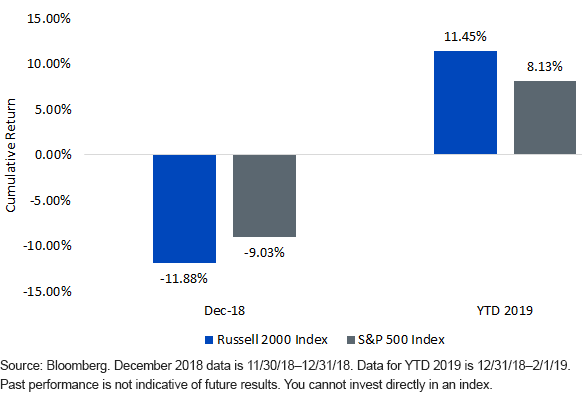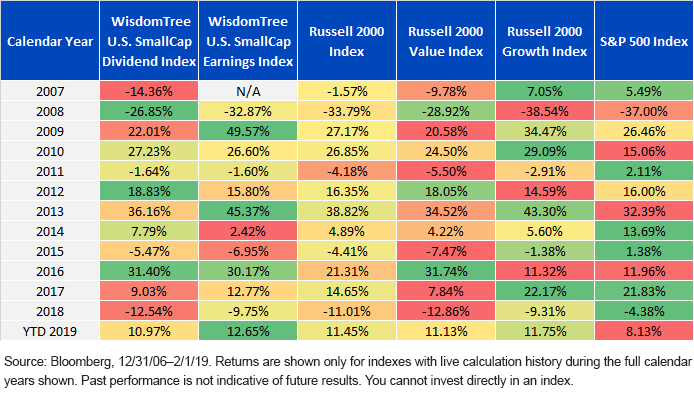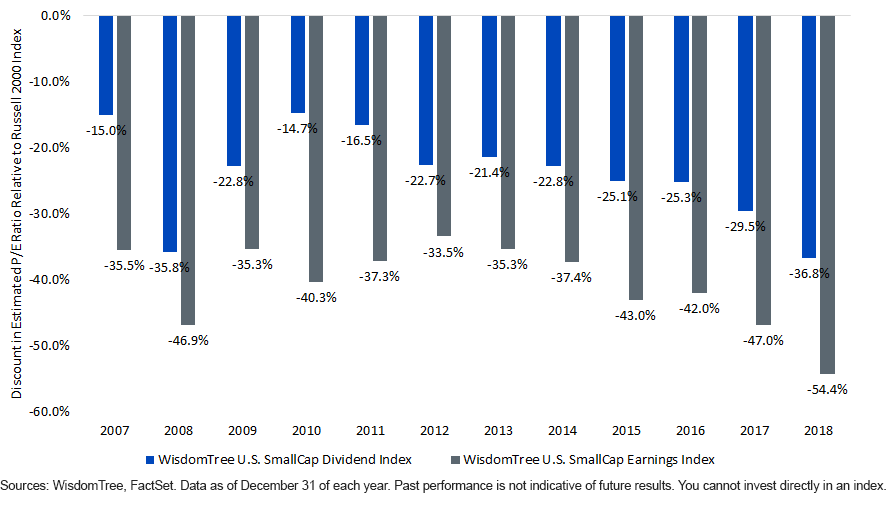It’s Time to Get Excited about U.S. Small Caps


When the VIX hit 36 at the end of December 2018, the last thing we would have thought would be that risk-on strategies might have a strong month in January 2019. It would have represented a strong trend reversal.
But it’s exactly what happened.
Late-Cycle Rallies Are Not Unusual
2018 was a volatile year—and it felt even more volatile than it was because the risk that had manifested in 2017 was so low. There is also no question that the U.S. economy is late in the current cycle. The current expansion by the National Bureau of Economic Research (NBER), measured during the summer of this year, indicated that we may see the longest expansion on record in the post-World War II period.
Growth is slowing as the strong stimulus provided by the 2017 tax cuts wears off. But it’s important to recognize that corporate earnings growth is still alive and in double-digit territory as we begin 2019. Importantly:
- Policy remains the “X” factor. The final outcomes of the U.S. government shutdown, the U.S. vs. China trade discussions and the Brexit situation are all very difficult to predict. All we can do is try to bring discussions back to fundamentals, such as earnings, in order to better deal with short-term factors that have a higher likelihood of certain negative impacts.
- Figure 1 shows that in December 2018, when perceptions and sentiment were stressed and in risk-off mode, the Russell 2000 Index dropped farther than the S&P 500 Index. During the risk-on period in January 2019, the Russell 2000 Index outperformed the S&P 500 Index, showcasing the capability of small caps to respond quickly in a positive direction as conditions change.
There is no way to be certain that negative sentiment won’t rear its head again in 2019. But we believe in the diversification potential of having some allocation in small caps to respond quickly during those times when markets recover and sentiment shifts back into the risk-on mode.
Figure 1: Small Caps Respond Quickly to Changing Market Sentiment

So Many Choices…
Clearly, investors can simply focus on the Russell 2000 Index. But is it the best option? It’s an interesting question. The Russell 2000 Index also has value and growth options, not to mention the other quantitative, rules-based, small-cap strategies we have designed. From figure 2, it’s apparent that:
- The S&P 500 Index has been strong when measured on a calendar-year basis against these indexes, coming out ahead in many of the years shown.
- The Russell 2000 Growth Index, at least among the other small-cap indexes shown, has done well. It’s clear that this period was characterized by growth outperforming value. The Russell 2000 Value Index, consequently, had a more difficult period.
- There are two WisdomTree Indexes shown. They are both quantitative, rules-based strategies for U.S. small-cap equities. From a performance perspective, like any strategy, they show some strong years, some poor years and many years somewhere in the middle.
Figure 2: What Has and What Hasn’t Worked in U.S. Small Caps

WisdomTree’s Indexes—So What?
No matter how we look at it, U.S. small-cap equities have significant risks. Sometimes these risks compensate investors with strong returns—but sometimes risk is just risk.
WisdomTree’s strategies seek to mitigate risks in different ways. And that is why they diverge from the market cap–weighted positioning of the Russell 2000 Index (as well as its value and growth cuts).
- The WisdomTree U.S. SmallCap Dividend Index includes only dividend-paying companies and weights those firms on the cash dividends they pay. Valuation risk is mitigated, as companies with more established businesses tend to commit to paying regular dividends.
- The WisdomTree U.S. SmallCap Earnings Index only includes companies with proven profitability, weighted by the earnings that they’ve generated. Valuation risk is also mitigated here, but the approach is broader and more core-oriented, capturing growth companies that may not pay dividends but that do have positive profits.
Before underestimating these risk-mitigation techniques, remember that the Russell 2000 Index tends to have approximately 20% of its weight in companies that have had negative earnings over the prior year.
Which of These Strategies Looks Strong NOW?
While the stories sound good, we believe that data is necessary to figure out which of the strategies might be the most strongly positioned for 2019. In figure 3, we measured the difference in forward P/E ratio between each WisdomTree Index and the Russell 2000 Index at the end of each specified year, as of December 31.
Figure 3: Massive Discounts to Start 2019 for WisdomTree Strategies

Conclusion: Be Ready for Late Cycle Rallies
At the end of 2018, the WisdomTree U.S. SmallCap Earnings Index indicated a forward P/E ratio that was more than 54% less expensive than the Russell 2000 Index. The WisdomTree U.S. SmallCap Earnings Index has been in live calculation since February 1, 2007, and has never ended a year with a discount like it has now. This tells us that, if there are to be late-cycle rallies and a bit of multiple expansion in U.S. small caps, this strategy may have the potential to capitalize.

Christopher Gannatti began at WisdomTree as a Research Analyst in December 2010, working directly with Jeremy Schwartz, CFA®, Director of Research. In January of 2014, he was promoted to Associate Director of Research where he was responsible to lead different groups of analysts and strategists within the broader Research team at WisdomTree. In February of 2018, Christopher was promoted to Head of Research, Europe, where he was based out of WisdomTree’s London office and was responsible for the full WisdomTree research effort within the European market, as well as supporting the UCITs platform globally. In November 2021, Christopher was promoted to Global Head of Research, now responsible for numerous communications on investment strategy globally, particularly in the thematic equity space. Christopher came to WisdomTree from Lord Abbett, where he worked for four and a half years as a Regional Consultant. He received his MBA in Quantitative Finance, Accounting, and Economics from NYU’s Stern School of Business in 2010, and he received his bachelor’s degree from Colgate University in Economics in 2006. Christopher is a holder of the Chartered Financial Analyst Designation.

